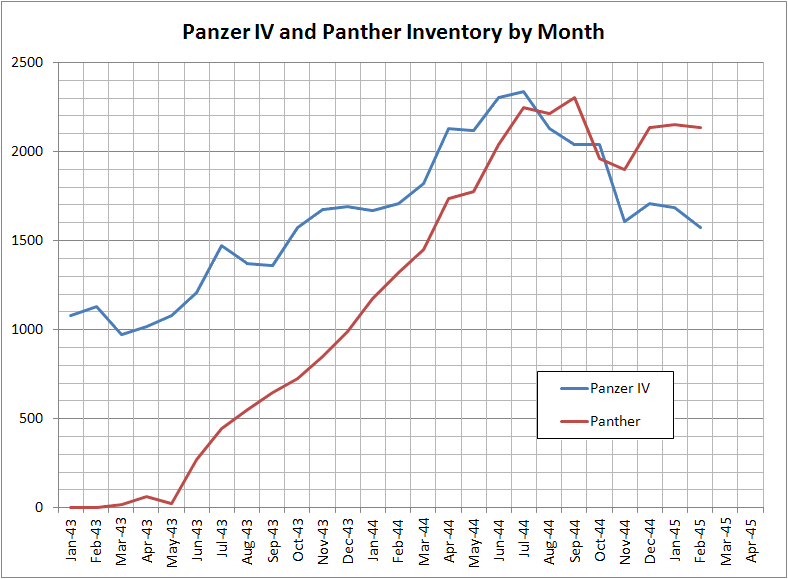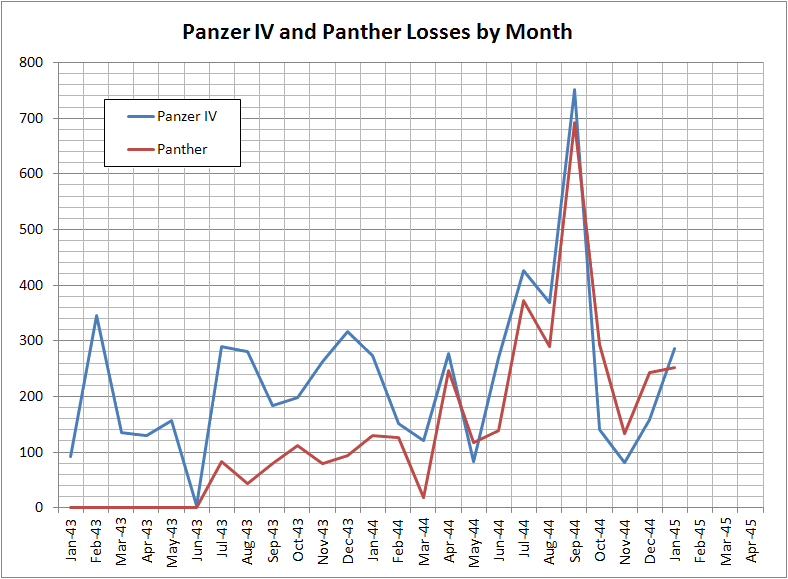One criticism leveled at many late-war German armored company lists in Flames of War is that there are "too many Panthers" and "not enough Panzer IV's." The perception being that the Panther was a rarer tank on the battlefield compared to the Panzer IV. While player preference may be changing with the introduction of many high-AT Allied weapons in the Bulge and forthcoming Market Garden releases, I wanted to take a look at the actual production numbers to understand how common the Panther tank really was relative to the Panzer IV, especially in late war. One of the best resources for this sort of data is Jentz's Panzer Truppen Volume 2. This book is a treasure trove of raw data, but it is generally not presented in a very visual format. When it is, somewhat clunky black and white bar graphs are used. So I took that data and reformatted to highlight the production and inventory levels of both vehicles.
The first data I examined was the actual production rate of both the Panther and the Panzer IV. The graph below shows that starting in 1943 Panther production (in red) ramped very quickly effectively matching Panzer IV production (in blue) by the end of 1943 and actually outstripping it in March, 1944.
Given the production numbers, one would expect the number of Panthers in the total inventory to rise relative to the Panzer IV assuming similar rates of attrition. Looking at the actual German panzer inventory by month, this is exactly what one sees. The graph below shows both the number of Panzer IV's (in blue) and Panther (in red) in the German arsenal growing steadily from January 1943 through mid-June 1944. The slope of the Panther line, however, is much steeper, so that by June 1944 there are roughly as many Panthers in service as there are Panzer IV's (just north of 2200 of each). Past that point and through the end of the war, the number of Panthers in service is actually greater than the number of Panzer IV's.
Clearly June 1944 was an inflection point in German armored strength. Despite Allied bombing and reversals in Italy and on the Eastern Front through 1943 and early 1944, the German Panzer force continued to grow. However, June 1944 saw both the Allied invasion of Normandy and perhaps more importantly from a pure numbers standpoint, Operation Bagration in the East. The chart of Panzer loses below shows a sharp spike in June-July 1944 coinciding with these operations.
From a pure numbers standpoint it is clear that at the time of the Normandy invasions and Operation Bagration, the Panther was just as common as the Panzer IV on the battlefield. Past that point, the Panther actually became more slightly more common than the Panzer IV. Another point to consider is the fact that armored divisions typically were organized using a single model of tank at the company level, so Panthers and Panzer IV's would each form their own companies, so "Panther heavy" German armored companies do actually have a strong historical basis.



This is something I was surprised to find out when I was reading "Hungary:- The Panzers last stand". It has a similar chart to the one you have above but just on the Panzers in Hungary and the rest of the Eastern Front. It was shocking because like you I thought there should be more Panzer IV's than Panthers.
ReplyDeleteGreat write up.
Ben
I sort of figured the Panther numbers were higher than was commonly believed before I hit the book. I was a little surprised at how high they were, but have since found out additional information that explains how the gap was closed - including a substantial drop in production cost. I'm hoping to post that data later! :D
ReplyDeleteVery informative article, for some reason I did have the perception that PIVs would have been more common. Though it makes sense that as the battlefield technology shifted that there would be a relative shift towards focussing on the better Panther.
ReplyDelete